Today we have our Linux benchmarks and review of the AMD EPYC 7301 CPU in a dual-socket configuration. The AMD EPYC 7301 is a dual socket capable part which is we see the most common deployment scenarios for the chip. In practice, we expect the most common single socket EPYC 7301 deployment scenario will be in dual socket capable servers that eye the potential of adding a second CPU later in the lifecycle. Otherwise, the AMD EPYC 7351P makes a more compelling single socket server chip which is part of AMD’s product and pricing strategy.
Key stats for the AMD EPYC 7301: 16 cores / 32 threads, 2.2GHz base and 2.7GHz turbo with a whopping 64MB L3 cache. The CPU features a 155-170W TDP. Here is the AMD product page with the feature set. Here is the lscpu output for the processor:

The key here is that the dual socket AMD EPYC 7301 uses an eight NUMA node implementation. You can read more about why in our AMD EPYC 7000 Series Architecture Overview for Non-CE or EE Majors article or learn about it in this video:
Test Configuration
For our tests we have been using a Supermicro Ultra platform configured as follows:
- System: Supermicro 2U Ultra EPYC Server (AS-2023US)
- CPUs: 2x AMD EPYC 7301 16-core/ 32-thread CPUs
- RAM: 256GB (16x16GB DDR4-2666)
- OS SSD: Intel DC S3710 400GB
- NIC: Mellanox ConnectX-3 Pro 40GbE
We wanted to highlight one important point of this system. It was the first AMD EPYC system in our labs and it is one that our readers have already started to deploy. We have met (in person) readers who started deploying these servers in August 2017. There is a lot of discussion regarding when one can actually buy EPYC systems. The Supermicro AS-2023US has been on sale to customers since August 2017 and was available well before many other dual socket systems such as the HPE ProLiant DL385 Gen10.
While the system may run with both DDR4-2400 and DDR4-2666 RAM, we stand by our recommendation that anyone purchasing an AMD EPYC 7000 series system, especially a dual socket one, use only DDR4-2666.

This configuration has seen at least eight teardowns to install different CPUs and has proven to be extremely serviceable. The fact that it follows the same form factor and has similar expansion options to the Intel-based versions of the Supermicro 2U Ultra platforms makes it easily interchangeable within a rack. Those who are accustomed to the Intel versions simply need to add a T20 driver for the AMD SP3 socket and they will be right at home working on the AS-2023US.
Dual AMD EPYC 7301 Benchmarks
For this exercise, we are using our legacy Linux-Bench scripts which help us see cross-platform “least common denominator” results we have been using for years as well as several results from our updated Linux-Bench2 scripts. At this point, our benchmarking sessions take days to run and we are generating well over a thousand data points. We are also running workloads for software companies that want to see how their software works on the latest hardware. As a result, this is a small sample of the data we are collecting and can share publicly. Our position is always that we are happy to provide some free data but we also have services to let companies run their own workloads in our lab, such as with our DemoEval service. What we do provide is an extremely controlled environment where we know every step is exactly the same and each run is done in a real-world data center, not a test bench.
Python Linux 4.4.2 Kernel Compile Benchmark
This is one of the most requested benchmarks for STH over the past few years. The task was simple, we have a standard configuration file, the Linux 4.4.2 kernel from kernel.org, and make the standard auto-generated configuration utilizing every thread in the system. We are expressing results in terms of compiles per hour to make the results easier to read.
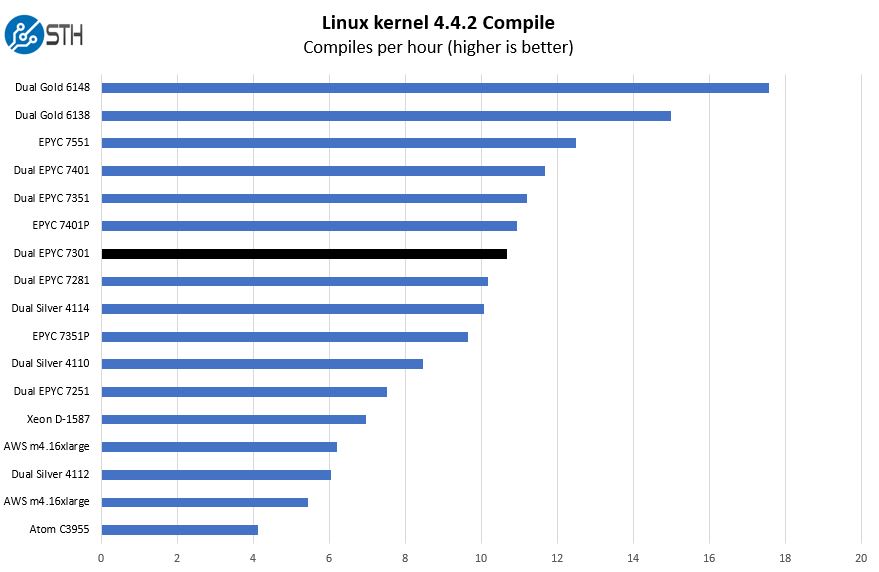
Here the dual AMD EPYC 7301 configuration performs well. We are adding the single socket parts where “P” series AMD EPYC parts are available here. That way one can thoughtfully compare benefits of a single socket configuration. With AMD EPYC, one gets the same 128 high-speed IO (PCIe/ SATA) lanes on both single and dual socket platforms.
c-ray 1.1 Performance
We have been using c-ray for our performance testing for years now. It is a ray tracing benchmark that is extremely popular to show differences in processors under multi-threaded workloads. Her e are the legacy 4K results.
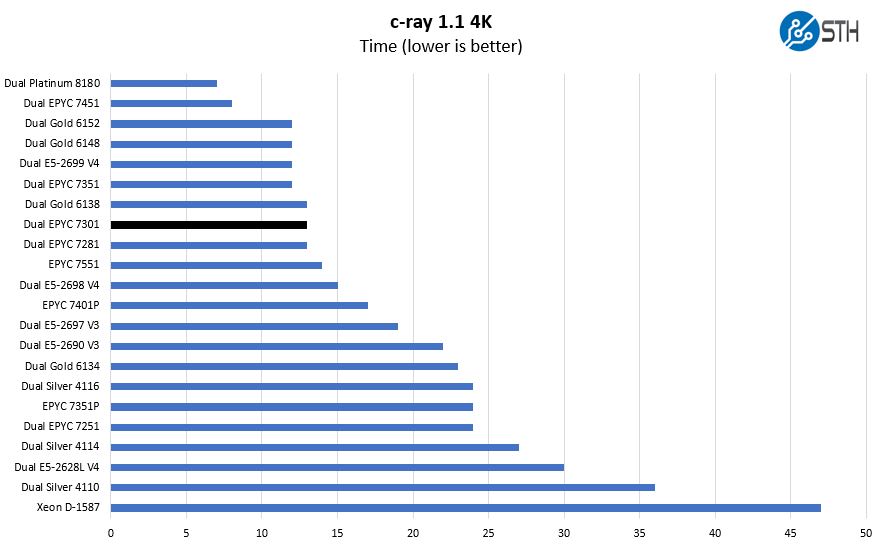
And here are the Linux-Bench2 8K results.

This is typically a strong workload for AMD, and we can see evidence of this here. AMD has a fast L1/ L2 cache so this is the type of benchmark that AMD likes to highlight.
7-zip Compression Performance
7-zip is a widely used compression/ decompression program that works cross-platform. We started using the program during our early days with Windows testing. It is now part of Linux-Bench.

Here we see strong compression/ decompression performance from the AMD EPYC platform.
NAMD Performance
NAMD is a molecular modeling benchmark developed by the Theoretical and Computational Biophysics Group in the Beckman Institute for Advanced Science and Technology at the University of Illinois at Urbana-Champaign. More information on the benchmark can be found here. We are going to augment this with GROMACS in the next-generation Linux-Bench in the near future. With GROMACS we have been working hard to support Intel’s Skylake AVX-512 and AVX2 supporting AMD Zen architecture. Here are the comparison results for the legacy data set:

Since this is not using the higher-end AVX features, the AMD EPYC 7301 is very competitive with the Intel Gold series CPUs.
Sysbench CPU test
Sysbench is another one of those widely used Linux benchmarks. We specifically are using the CPU test, not the OLTP test that we use for some storage testing.

In terms of sysbench performance, one can see that the AMD EPYC platform scores appreciably well as this scales without much NUMA impact.
OpenSSL Performance
OpenSSL is widely used to secure communications between servers. This is an important protocol in many server stacks. We first look at our sign tests:

Here are the verify results.
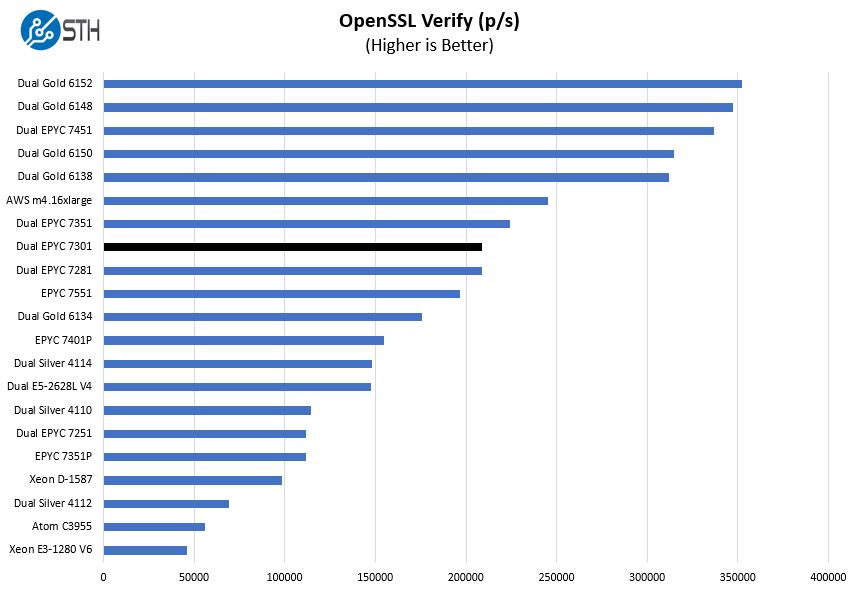
As you can see, there is strong OpenSSL performance. One can also see that one gets a lot of benefit moving to dual 24 core AMD parts over the various 16 core grades.
UnixBench Dhrystone 2 and Whetstone Benchmarks
Some of the longest-running tests at STH are the venerable UnixBench 5.1.3 Dhrystone 2 and Whetstone results. They are certainly aging, however, we constantly get requests for them, and many angry notes when we leave them out. UnixBench is widely used so we are including it in this data set. Here are the Dhrystone 2 results:
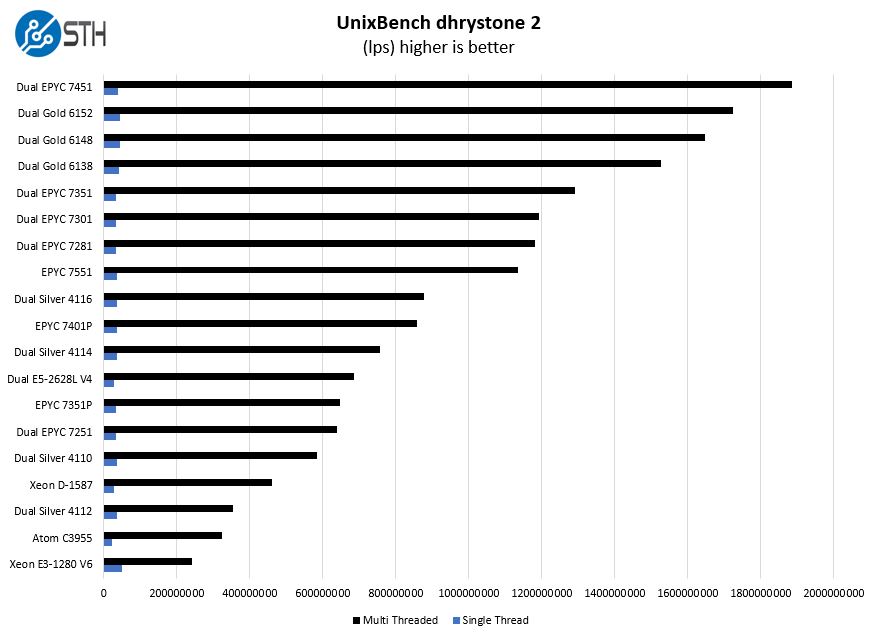
And the whetstone results:

This is one where performance is extremely strong even on a legacy workload. At this price point, performance is hard to beat.
GROMACS STH Small AVX2/ AVX-512 Enabled
We have a small GROMACS molecule simulation we previewed in the first AMD EPYC 7601 Linux benchmarks piece. In Linux-Bench2 we are using a “small” test for single and dual socket capable machines. Our medium test is more appropriate for higher-end dual and quad socket machines. Our GROMACS test will use the AVX-512 and AVX2 extensions if available.
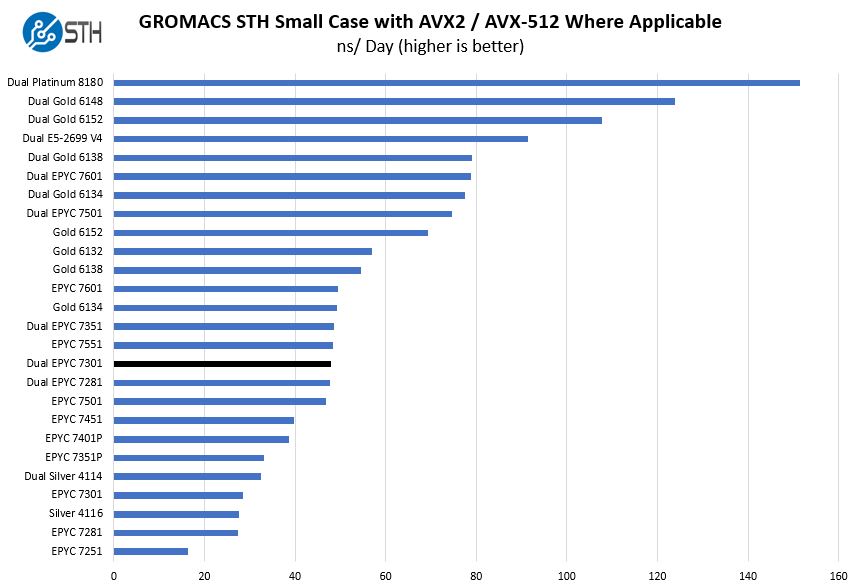
Here we can start to see the impacts of using AVX-512 on the Xeon Gold series where performance can be blistering for applications that can use it. Unlike Intel’s internal GROMACS comparison numbers, we have patches both for AMD AVX2 and Intel AVX-512 installed on this.
Chess Benchmarking
Chess is an interesting use case since it has almost unlimited complexity. Over the years, we have received a number of requests to bring back chess benchmarking. We have been profiling systems and are ready to start sharing results:
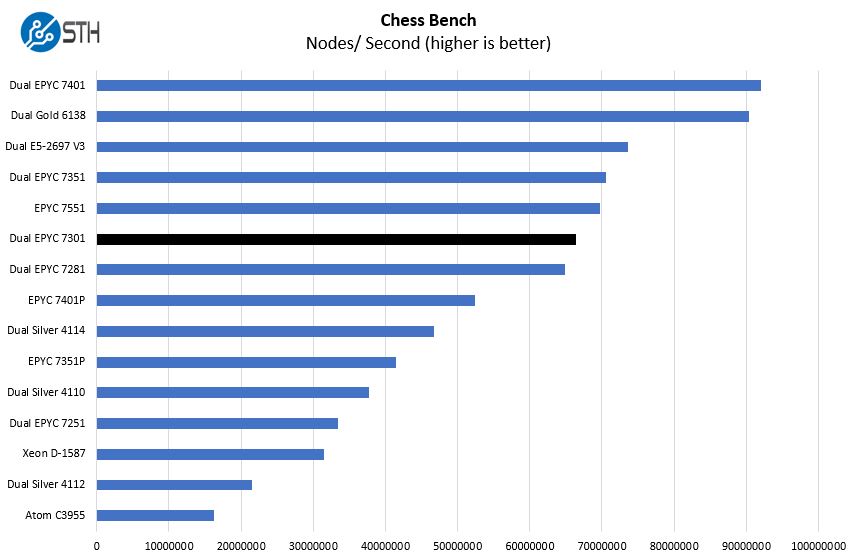
Again we have a strong performance from the dual AMD EPYC 7301 configurations.
A Note on Power Consumption
The other side of the equation is power consumption. The AMD EPYC 7301 is putting up some impressive benchmark numbers, but that does have an associated cost. Here is what we saw on our PDU after a few runs:
- Idle: 117W
- 70% Load: 247W
- 100% Load: 330W
- Peak: 345W
Note these results were taken using a 208V Schneider Electric / APC PDU at 17.6C and 71% RH. Our testing window shown here had a +/- 0.3C and +/- 2% RH variance. The figures are certainly more than the Intel Xeon Silver line, but with that extra power consumption, AMD is delivering a more expandable platform and more performance.
Market Positioning
Thes chips are not released in a vacuum instead, they have competition on both the Intel and AMD sides. When you purchase a server and select a CPU, it is important to see value of a platform versus its competitors.
2P AMD EPYC 7301 v. AMD EPYC
Looking at the AMD EPYC line, it is clear where this falls compared to other chips in the dual socket series. One can stay at 16 cores per chip and move up to the EPYC 7351 or down to the EPYC 7281 to fine-tune performance per dollar. If you want performance, we suggest simply moving to the EPYC 7401 (or higher) as adding 50% more cores has a large impact on performance.
Another fascinating note here is that AMD also has 24 and 32 core single socket capable parts that are priced attractively in the AMD EPYC 7401P and EPYC 7551P. If you do not require additional memory slots, those are great options. We can see that the AMD EPYC 7551 single socket configuration is often comparable to the dual AMD EPYC 7301 which makes sense given the similar core counts.
2P AMD EPYC 7301 v. Intel Xeon Scalable
On the Intel side, the Intel Xeon Silver lines are priced somewhat competitively between the Intel Xeon Silver 4114 and 4116. At the same time, those are low wattage parts with half the TDP of the AMD EPYC 7301. Accordingly, the dual AMD EPYC 7301 performance wise is more comparable to Intel Xeon Scalable Gold series CPUs at twice the price.
Final Words
The AMD EPYC 7301 dual socket configuration is a great balance between comptue and performance. The EPYC 7301 is the lowest-cost SKU that is dual socket capable and that has a massive 64MB L3 cache per chip. If you are running L3 cache heavy workloads, there is no reason to go lower in the AMD SKU stack. Moving up the stack to the 7351 is mostly a clock speed upgrade but the big boost comes by adding 50% more cores with the EPYC 7401. Moving up to 24 cores is a $1000 per chip upgrade and worthwhile in many applications. If you just need I/O and lots of RAM with relatively fewer cores, then the AMD EPYC 7301 dual socket configuration has expansion capabilities that Intel simply cannot match, especially at this price level.


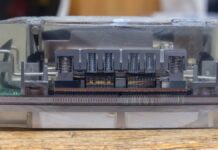


I know this might be a fad but it could drive more traffic to STH if crypto benchmarks were added to reviews going forward.
I liked the write up though looks like a compelling chip.
Hey Patrick,
do you know when epyc boards with mote then 6x pci e will be abailable?
Tanks for the benchmarks!
I would like to see a comparison for an EPYC system with different kinds of memory. Here I mean, single rate, dual rate and perhaps quad rate memory. From the CPU benchmarks at spec.org I can see that quad rate memory performs the best (about 10 % faster than dual rate memory), but quad rate memory are load reduced memory that only comes in large chunks, 64 MB per DIMM I think. At spec.org I can’t find a single EPYC result with single rate memory, which I guess is a bad sign for that kind of memory. Please make a comparison between single rate DDR4-2666 with dual rate DDR4-2400. If the dual rated memory can run at 2666 please include that in the comparison as well. Thanks!
Erik do you mean dual rank and dual socket? I’m deathly curious about that too.
Gigabyte’s board spec suggests that filling two slots per channel would allow down everything to 2133. That would be really sad for an otherwise ubiquitous board that fits in a non specialty case.
Sorry, I meant rank all the places I wrote rate.
A test of different memory types could be done on any EPYC system, dual or single socket as long as it is keept stable when memory is changed.
A far more interesting test would be a Virtualization, imho.
We are a small company advising on clusters and storages running in VMware environments, but we are also catering to the Hyper-V, KVM and XEN crowd.
So a test running different hypervisor solutions on AMD Epyc CPUs would be very welcome.
Thanks for the feedback Jens. We may start publishing some of our KVM data as part of our next update. We do have folks using our DemoEval machines to show clients virtualization solutions on EPYC.
I think STH will get a lot of work benchmarking software on EPYC in the coming days, weeks, months because of the KPTI bug in all intel processors since they use KPTI.